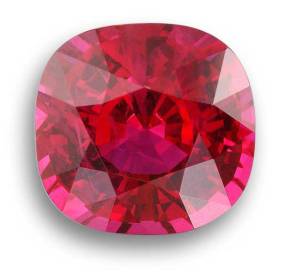
Ruby photo courtesy of the AGTA.
Noted in ancient Sanskrit writings and the Bible as the most precious of all gemstones, rubies have been the prized possession of emperors and kings throughout the ages. Ruby’s inner fire has been the inspiration for innumerable legends and myths, and to this day, no red gemstone can compare to its fiery, rich hues. It was believed wearing a fine red ruby bestowed good fortune on its owner.
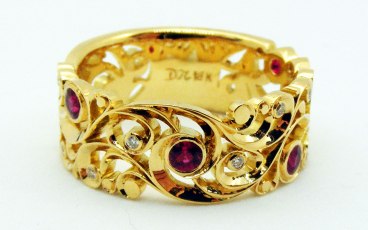
Hand-pierced and engraved ruby and diamond ring by Dmitriy Pavlov, available at Studio Jewelers – Madison, WI.
Many people associate its brilliant crimson colors with passion and love, making ruby an ideal choice for an engagement ring. Ruby is the red variety of the corundum mineral species, while all other colors of corundum are called sapphire. In the United States, a minimum color saturation must be met to be called a ruby; otherwise, the stone will be called a pink sapphire.
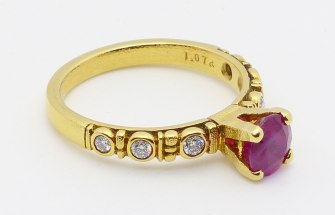
Alex Sepkus ring with 1.07 ct. ruby and diamonds, available at Studio Jewelers – Madison, WI.
Rubies have a hardness of 9.0 on the Mohs scale of mineral hardness. Among the natural gems only moissanite and diamond are harder, with diamond having a Mohs hardness of 10.0 and moissanite falling somewhere in between corundum (ruby) and diamond in hardness. This makes ruby an excellent choice for a ring or other piece of jewelry to be worn everyday.
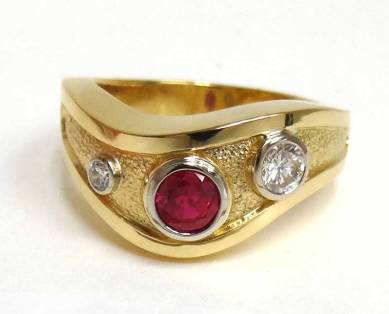
Custom made ruby and diamond ring by Chris Keenan.
This most sought after gemstone is available in a range of red hues, from purplish and bluish red to orangish red. Ruby is readily available in sizes up to 2 carats, but larger sizes can be obtained. However, in its finest quality, any size ruby can be scare. In readily available small sizes, ruby makes an excellent accent gemstone because of its intense, pure red color
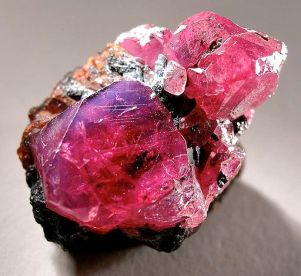
Ruby crystal, photo by Rob Lavinsky, iRocks.com via Wikipedia.
Ruby is mined throughout Southeast Asia, and historically, the Mogok Valley in Upper Myanmar (Burma) was for centuries the world’s main source for rubies. The Republic of Macedonia is the only country in mainland Europe to have naturally occurring rubies. A few rubies have been found in the U.S. states of Montana, North Carolina, South Carolina and Wyoming. The gemstone spinel is often found in the same gem gravel areas as ruby, and many famous historic gemstones thought to be rubies have been found to actually be spinel.
Despite all the best efforts of gemstone merchants to use technology to enrich color, fine ruby is still exceptionally rare. After being extracted from the earth, rubies today are commonly heated to high temperatures to maximize the purity and intensity of their red hue. Impurities may also dissolve or become less noticeable after heating. However, heating will only improve the color if the gemstone already contains the chemistry required.
———-
In addition to the above information from the AGTA, Wikipedia and other sources, you can find facts about these of gems and more at the “Gems and Gem Materials“ online course, through the University of California-Berkeley’s Department of Earth and Planetary Science. The website is available for the general public, and contains a wealth of information for the budding gemologist and anyone interested in learning more about gemstones. Hanna Cook-Wallace has contributed to this site, which was developed by Jill Banfield while teaching at the University of Wisconsin.